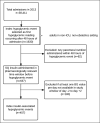PREVENTION AND MANAGEMENT OF INSULIN-ASSOCIATED HYPOGLYCEMIA IN HOSPITALIZED PATIENTS
- PMID: 27042740
- PMCID: PMC5996396
- DOI: 10.4158/EP151119.OR
PREVENTION AND MANAGEMENT OF INSULIN-ASSOCIATED HYPOGLYCEMIA IN HOSPITALIZED PATIENTS
Abstract
Objective: To determine whether appropriate therapeutic changes in insulin doses are made to prevent and manage insulin-associated hypoglycemic events in non-critically ill hospitalized patients.
Methods: This retrospective study was conducted in hospitalized adults on medical or surgical floors with insulin-associated hypoglycemia, excluding treatment with insulin infusions, insulin pumps, and parenteral nutrition. The first hypoglycemic event after 48 hours of admission was the index event. Over the 1-year study period, a total of 457 insulin-associated hypoglycemic events were included as index events.
Results: An indication for an insulin dose adjustment was identified in 32 and 42% of patients on day -2 and day -1, respectively, before the index hypoglycemic event, of which 35 and 55%, respectively, had an insulin dose reduction ≥10%. Following the hypoglycemic event, 44% of patients had an insulin dose reduction of ≥20%. Therapeutic reduction of the total daily insulin dose by ≥20% was associated with increased odds of normoglycemia and lower odds of hyperglycemia but was not associated with lower odds of recurrent hypoglycemia on the day following the index hypoglycemic event. There was a high prevalence of hypoglycemic risk factors in this population, with kidney disease and nil per os status being the most prevalent contributing factors.
Conclusion: Adherence to the current practice recommendation to reduce insulin doses in patients with borderline hypoglycemia and following overt hypoglycemia was modest. Further studies are needed to understand the associated risks and to define appropriate therapeutic changes for insulin treated patients with borderline and overt hypoglycemia.
Abbreviations: AKI = acute kidney injury BG = blood glucose CKD = chronic kidney disease ESRD = end-stage renal disease ICU = intensive care unit NPH = Neutral Protamine Hagedorn NPO = nil per os OR = odds ratio TDD = total daily dose.
Figures



Comment in
-
HOUSTON, WE HAVE A PROBLEM: COMMENTARY ON PREVENTION AND MANAGEMENT OF INSULIN-ASSOCIATED HYPOGLYCEMIA IN HOSPITALIZED PATIENTS.Endocr Pract. 2016 Dec;22(12):1453-1455. doi: 10.4158/EP161413.CO. Epub 2016 Sep 28. Endocr Pract. 2016. PMID: 27682349 No abstract available.
References
-
- Brutsaert E, Carey M, Zonszein J. The clinical impact of inpatient hypoglycemia. J Diabetes Complications. 2014;28:565–572. - PubMed
-
- Umpierrez GE, Hellman R, Korytkowski MT, et al. Management of hyperglycemia in hospitalized patients in non-critical care setting: an Endocrine Society clinical practice guideline. J Clin Endocrinol Metab. 2012;97:16–38. - PubMed
MeSH terms
Substances
Grants and funding
LinkOut - more resources
Full Text Sources
Other Literature Sources
Medical

